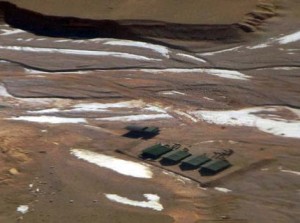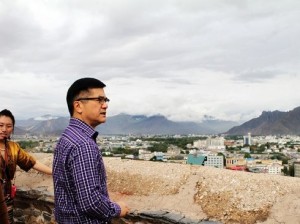
Aerial view of five tents erected by intruding Chinese troops inside Indian territory in Ladakh
Photo: Hindustan times
The past few months have seen rising tensions between Indian and Chinese troops in the much-disputed Ladakh border region. For the Tibetan exile community, whose fate hinges on the relationship between these two countries, such conflict could have its advantages. As prominent Indian political analysts have argued, whenever China indulges in anti-India activities, Indian authorities play “The Tibet Card” – with gestures such as meeting the Dalai Lama, or actively omitting endorsement of the “One China Policy” from diplomatic statements specifically intended to wind up Beijing.
India and China have had 15 rounds of fruitless border talks since the 1990s but the recent dispute is the most serious in 25 years. Earlier this year, Indian generals discovered a platoon of Chinese soldiers camping 10km across the border, sparking a standoff. In a recent diplomatic visit between Chinese Prime Minister, Li Keqiang and Indian PM, Manmoham Singh, no apology was made by the Chinese side for the recent incursion and India has since pledged to add 40,000 troops to the border. Relations between the neighbours have also been strained in recent years as China has developed military infrastructure near the border in Tibet and constructed dams on rivers that flow into India.
So how has, and critically how will, this relationship affect the 120,000 Tibetan exiles living in India?
India has long played a delicate balancing act between its loyalty, and role as host, to the Tibetan exile Community, and its pragmatic need to forge good economic relations with China as trade between the two countries is expected to reach $100 billion by 2015.
Currently, Tibetan refugees in India are granted the right to own land (in specific areas), to work, and to have access to healthcare and education. Indian officials and political experts frequently openly criticise China’s actions in Tibet. Under pressure from Beijing, Indian authorities do not allow Tibetans living in India to engage in “anti-china political activities” and the media is controlled from “irresponsible” dissemination of Tibet-related issues
However, this situation is not simply a question of moral versus economic concerns – some political analysts have argued that this situation has its advantages for India, giving them political leverage and a negotiating point against China. Srikanth Kondapalli, Chair for East Asian Studies at Nehru University, has said “Whenever there is a problem between India and China, India plays the Tibet card”. An example of this is the Indian Foreign Secretary’s meeting with the Dalai Lama at his residence in 2010, which has been linked to China’s disclosure the previous week of plans to build nuclear reactors for Pakistan.
Following the recent diplomatic visit between the Chinese and Indian Prime Ministers, the omission of the “One China Policy” from their joint statement is possibly another subtle way of playing “the Tibet card”, and could be indicative of persisting mistrust between the two countries. China seeks from every country, without exception, a commitment to the “One China Policy” (which states that Tibet is an “inalienable part of China”). It is described as a “fundamental Chinese core concern”. However, since 2010, India has actively omitted it, making the point that Kashmir is as much a core concern to India as Tibet is to China, and that China’s policies in the region violate this core concern. “We won’t make a unilateral commitment to Tibet without getting anything in return” said an Indian official. “If they had insisted on Tibet, then we would have asked for something else [Kashmir] to be included”.
Frosty Sino-Indian relations, highlighted by the recent border disputes, seem to maintain for now the secure position of the Tibetan exile community. However, if the countries’ mutual economic interests begin to outweigh political disagreements, this position could become less stable. Last year when Singh met the then Chinese President Hu Jintao and other market leaders to discuss their aims for trade between the two countries, Tibetan communities in Delhi were put under a virtual lockdown and hundreds of protesters were arrested. The current situation in Nepal, with China pumping money into the economy in exchange for brutal crackdowns on the Tibetan community, also provides a chilling warning.





 Print
Print Email
Email